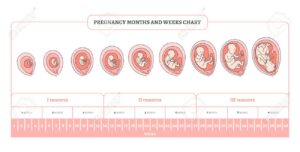Abortion – What Is It Really?

Pregnancy month, weeks and trimesters chart with stages of embryo development – infographic of process of human fetal growth in vector illustration isolated on white background.
FIRST THINGS FIRST
Before we get into what abortion is, we need to say, that just like adultery, drunkenness, fornication, or any other sin mentioned in the Bible, abortion is a sin. As the slogan goes, “Abortion stops a beating heart”. Abortion is killing a baby that is still in its mother’s womb. BUT, the sin of abortion is forgivable! If anyone who has been involved in abortion on any level will turn to Jesus Christ, pour out your heart to Him, and receive the forgiveness He has poured out for you through His precious blood, He WILL forgive you and you will stand before Him clean and pure as the driven snow WITHOUT condemnation.
This blog is to educate everyone on what abortion is because many people, especially women and even those working in the abortion industry, do not know what abortion entails.
ABORTION PROCEDURES
The abortion procedures that are used to kill a baby and remove him/her from his mother’s womb vary depending upon the stage of the baby’s development (i.e. how far along mom is in her pregnancy). Let’s remember that a baby’s heart begins to beat when mom is just 21 days pregnant! Most women don’t even know they’re pregnant yet. Even scientists agree that a baby’s life begins when the egg and the sperm meet at conception.
TYPES OF ABORTIONS
Medical Abortion
The first type of abortion is performed from conception to 5-9 weeks of pregnancy. The baby is about 1 ¼ inches long at this point and well formed and recognizable as a little human being. This type of abortion is called a “medical abortion”. A drug is either given orally or injected into the amniotic sac that will kill the baby. The most common drug given is Mifepristone (aka RU-486). Mifepristone destroys the placenta by breaking down the lining of the uterus. An additional drug, Misoprostol, is given to induce labor so that the dead baby can be delivered. As would be expected, the drug causes severe bleeding, and at times, vaccum aspiration may be needed to complete the abortion. Other potential risks include infection, fever, chills, diarrhea, headaches psychological and emotional distress. This procedure can be started in the doctor’s office and completed at home. It can take from 1-2 days to complete.
Vaccum Aspiration
The second type of abortion is called “vacuum aspiration” and is performed from 5-14 weeks of pregnancy. At this point in the pregnancy, the baby can be up to 4 inches long. Vacuum aspiration abortions are performed by inserting a plastic tube through the cervix (called a cannula). A suction pump is attached to the other end of the tube with a bottle to collect the pieces of the baby that are suctioned out. The suction pump is turned on and will pull the baby and placenta out of the uterus. If the baby is too big to fit through the tube, the suction will pull the baby’s body in pieces. These pieces must be identified later to ensure the entire baby is removed. Sometimes the tube will not be able to dismember the baby, so the doctor will pull the baby out using forceps. The baby will die in the uterus or may be left to die in the suction bottle.
The baby is alive while it is being suctioned into pieces. The risks to the mother during vacuum aspiration include cramping, heavy bleeding, damage to the uterus and/or cervix, psychological and emotional distress.
Dilation and Evacuation
The third type of abortion is called “dilation and evacuation” (D&E). A D & E is done from 12 weeks up to birth. The baby can range from 3” to birth size (18” or more). During this procedure, the mother’s cervix is dilated. Forceps are inserted into the uterus and the baby is pulled to pieces in order to be removed. Babies that are larger are first killed, either by poisoning with an injection of digoxin or potassium chloride, or by cutting their umbilical cord and allowing them to bleed to death. By killing the baby first, the tissue of the baby is softened and becomes easier to pull apart during the evacuation.
Larger babies are delivered in the breech position, feet first. If the baby is not in the breech position, forceps or manual manipulation are used to turn the baby breech. If the baby’s head is too large to fit through the birth canal as it is being removed from the uterus, an incision is made at the base of the skull, the baby’s brain is suctioned out and the skull is crushed using forceps. This allows for easier removal of the baby from the uterus. Suction is used to clean out the uterus.
The risk of injury to the uterus, cervix and vagina are higher in this abortion procedure because the baby’s bones are harder and sharp fragments can cause damage
.Hysterotomy
The final abortion procedure is called a Hysterotomy. Hysterotomy refers to a caesarean delivery as an abortion method. It is used in some late-term abortions. The woman’s abdomen and uterus are opened surgically and the baby is removed. Before the surgery, the baby is given digoxin or potassium chloride to ensure the baby is dead upon delivery. Risks to the mother from this type of abortion include cramping, infection, and a generally higher risk of complications, up to and including death, as with any major surgery.
Failed abortions are not uncommon. For more information on those individuals that survived a failed abortion, we refer you to the “Abortion Survivors” website.
Aborted Babies – What happens?
The Bible teaches us that when the body dies, our spirit returns to God, our Creator. Every baby that has been killed by abortion is in the presence of Almighty God and Jesus Christ. If the mother of an aborted baby is also born-again, she will also enter the presence of Jesus when she dies. Mother and child will be reunited in Heaven to spend all eternity together. There will be no condemnation or remorse, only joy and gladness.
REASONS FOR ABORTION
- Interference with career or education 25%
- Can’t afford a baby 23%
- Relationship problems / single mom 16%
- Has all the children she wants 12%
- Not ready for child / responsibility 10%
- Feels she isn’t mature enough 7%
- Parents / partner wants abortion 6%
- Mother’s health at risk / rape / incest 1%
Reference:
Finer, Lawrence, “Reasons U.S. Women Have Abortions”
